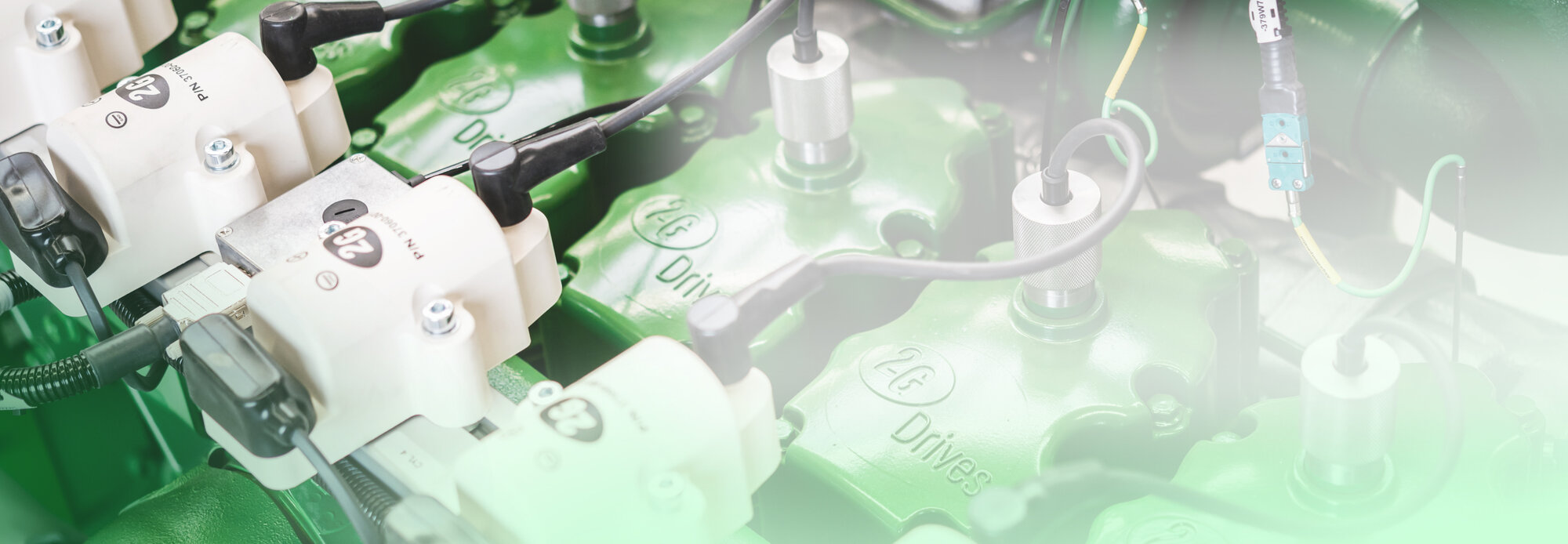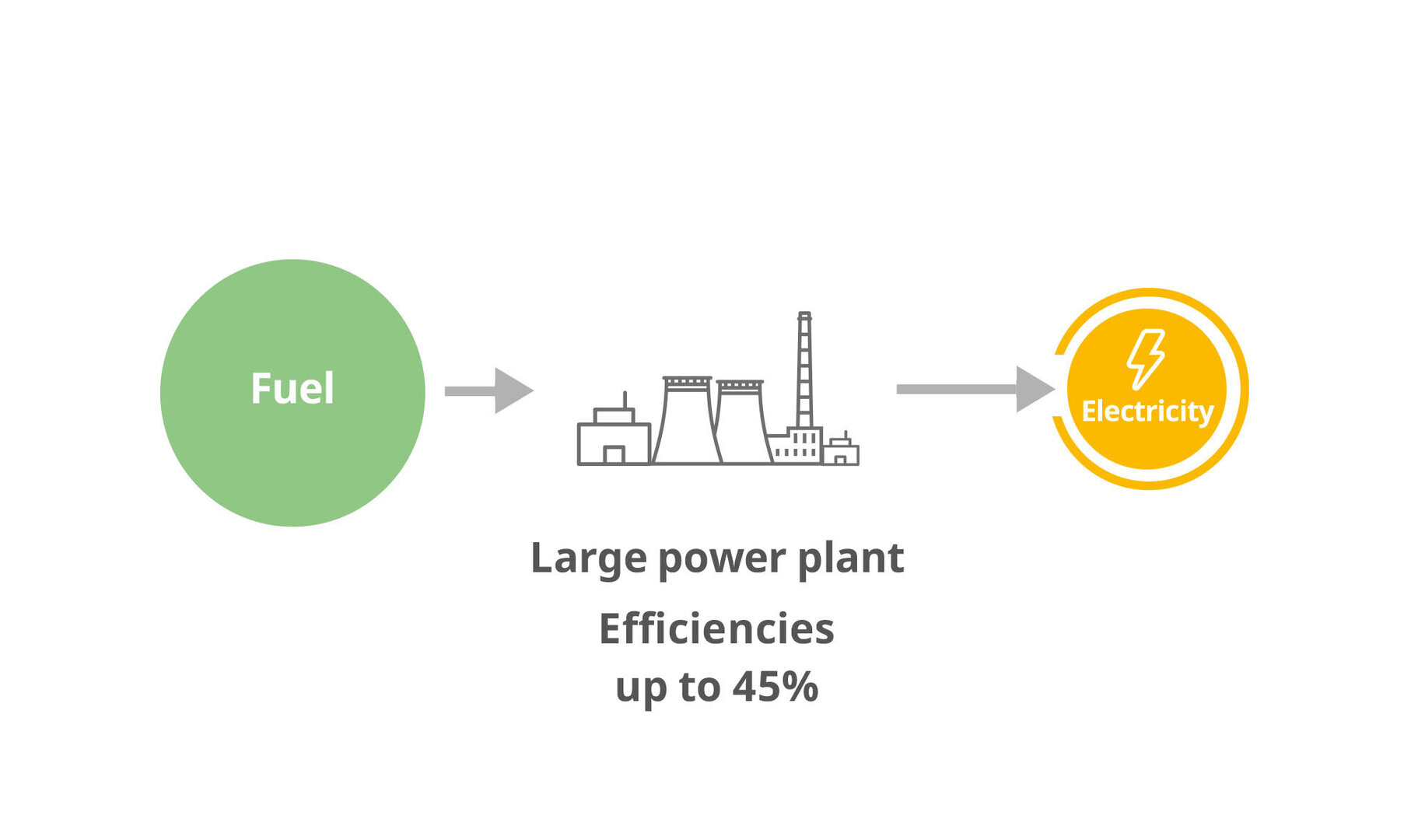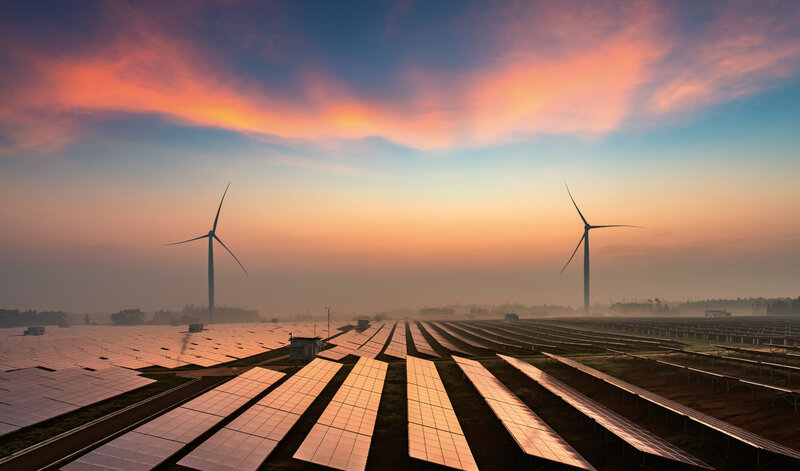
Kogeneracja
Wszystko, co warto wiedzieć w skrócie
Technologia będąca podstawą naszych systemów skojarzonego wytwarzania ciepła i energii elektrycznej (CHP) nazywana jest kogeneracją. Terminy wytwarzanie ciepła i energii elektrycznej w skojarzeniu oraz kogeneracja są często używane zamiennie. Na tej stronie przedstawiamy tę technologię, wyjaśniamy, jak działa i pokazujemy, jaką rolę może odegrać w strukturze dostaw energii dziś i w przyszłości.
Czym jest kogeneracja?
Kogeneracja to termin używany do opisania połączonego wytwarzania energii elektrycznej i cieplnej, częściej nazywanej energią elektryczną i ciepłem. W przeciwieństwie do oddzielnego wytwarzania, które często wiąże się ze znacznymi stratami energii, kogeneracja wyróżnia się ogromną wydajnością, co skutkuje niskim zużyciem paliwa, niską emisją gazów cieplarnianych i wyższą efektywnością ekonomiczną.
Zasada skojarzonego wytwarzania ciepła i energii elektrycznej

Konwencjonalne elektrownie (centralne)
W konwencjonalnym wytwarzaniu energii w dużych scentralizowanych elektrowniach, wytworzone ciepło ucieka niewykorzystane do atmosfery.

Skojarzone wytwarzanie ciepła i energii elektrycznej (decentralne)
Kogeneracja wykorzystuje również ciepło odpadowe generowane podczas produkcji energii elektrycznej. W ten sposób uzyskuje się znacznie wyższe wartości wydajności niż w przypadku oddzielnego wytwarzania.


Co należy rozumieć przez „zdecentralizowane dostawy energii”?
Kogeneracja jest środkiem zdecentralizowanej produkcji energii, co oznacza, że energia jest zwykle wytwarzana bezpośrednio w miejscu jej zużycia. W przeciwieństwie do scentralizowanej elektrowni, która stanowi węzeł w scentralizowanej infrastrukturze dostaw energii i zasila ją energią, produkcja energii w systemach skojarzonego wytwarzania ciepła i energii elektrycznej może być całkowicie niezależna od publicznej sieci energetycznej. Zwiększa to bezpieczeństwo dostaw, ponieważ moce wytwórcze są rozproszone.
Jak działa kogeneracja?
Głównymi komponentami kogeneracji są silnik, generator i wymiennik ciepła, a także jednostki sterujące i kontrolne. Zwykle częścią systemu są również dodatkowe komponenty, takie jak układ wydechowy, urządzenia wentylacyjne itp. Dokładne wyposażenie zależy od konkretnego zastosowania.
Silnik spalinowy napędza generator, który z kolei wytwarza energię elektryczną. Ciepło generowane przez spalanie paliwa wewnątrz silnika spalinowego nie jest usuwane - jak miałoby to miejsce na przykład w samochodzie - przez układy chłodzenia bez wykorzystania, ale jest udostępniane sieci grzewczej za pośrednictwem wymiennika ciepła. W ten sposób wykorzystywane jest do 98% energii pierwotnej, a mianowicie w postaci energii elektrycznej i ciepła.
Jednak systemy skojarzonego wytwarzania ciepła i energii elektrycznej są w stanie nie tylko zapewnić ogrzewanie lub ciepłą wodę. Możliwe jest również wytwarzanie ciepła procesowego za pomocą pary, gorącego powietrza lub oleju termalnego. Jest to najczęściej stosowane w przemysłowych procesach produkcyjnych.
W przypadku systemów skojarzonego wytwarzania ciepła i energii elektrycznej napędzanych silnikiem obowiązują następujące zasady: Moc elektryczna kogeneratora bezpośrednio odpowiada jego sprawności elektrycznej - w tym przypadku więcej zwykle oznacza więcej.
Systemy kogeneracyjne mogą być zasilane zarówno paliwami kopalnymi, jak i odnawialnymi. Paliwa płynne, takie jak domowy olej opałowy, olej roślinny lub biodiesel, mogą być stosowane w silnikach z zapłonem samoczynnym. Paliwa gazowe, takie jak gaz ziemny, gaz płynny i biogaz (a także gazy ubogie z niewielką zawartością metanu nadającego się do spalania, takie jak gaz ściekowy, gaz wysypiskowy lub gaz kopalniany) są stosowane w silnikach Otto, silnikach dwupaliwowych lub turbinach gazowych.
W kontekście postępującej transformacji energetycznej, wodór jest głównym kandydatem do stania się powszechnie wykorzystywanym, neutralnym dla klimatu źródłem energii. Może być produkowany z nadwyżek energii wiatrowej i słonecznej. Systemy skojarzonego wytwarzania ciepła i energii elektrycznej 2G już teraz są w stanie wytwarzać ciepło i energię elektryczną przy użyciu wyłącznie 100% wodoru.
Kiedy wykorzystanie skojarzonej produkcji ciepła i energii elektrycznej jest opłacalne?
Systemy skojarzonego wytwarzania ciepła i energii elektrycznej są dostępne w różnych kategoriach mocy. Portfolio produktów 2G składa się z rozwiązań o mocy od 20 do 4500 kW, obejmujących szeroki zakres zastosowań. Ponieważ każdy system kogeneracyjny firmy 2G może być specjalnie dostosowany do zamierzonego zastosowania i jest planowany jako część całościowego rozwiązania, względy efektywności ekonomicznej odgrywają kluczową rolę od samego początku.
Kogeneracja może być obsługiwana z naciskiem na ciepło lub energię elektryczną. Koncentracja na energii elektrycznej oznacza, że konfiguracja i działanie CHP zależą od zapotrzebowania na energię elektryczną. Z drugiej strony, przy nastawieniu na ciepło, czynnikiem decydującym jest zapotrzebowanie na ciepło. W razie potrzeby można również pokryć zapotrzebowanie na dodatkowe źródła energii, takie jak na przykład chłodzenie.
Zazwyczaj celem jest uzyskanie najwyższego możliwego stopnia wykorzystania systemu, co prowadzi do jak najpełniejszego wykorzystania dostępnych mocy produkcyjnych. Jednak zapotrzebowanie na elastycznie aktywowane moce regulacyjne i bilansujące rośnie równolegle z ekspansją odnawialnych źródeł energii, które z natury podlegają wahaniom mocy - a kogeneracja doskonale spełnia tę potrzebę.
Czy kogenerację można uznać za odnawialną?
Centralnym elementem systemu skojarzonego wytwarzania ciepła i energii elektrycznej jest silnik tłokowy. To, czy energię produkowaną w kogeneracji można uznać za odnawialną, zależy wyłącznie od paliwa.
Fakt pozostaje jednak faktem: Nawet w przypadku stosowania paliw kopalnych, takich jak gaz ziemny, kogeneracja znacznie przewyższa wydajność konwencjonalnej produkcji energii. Dodatkowo, szkodliwe gazy nieuchronnie wytwarzane przez wysypiska śmieci i oczyszczalnie ścieków mogą być wykorzystywane do produkcji energii, a tym samym usuwane ze środowiska - dwie wygrane jednocześnie.
Dlatego kogeneracja już teraz przyczynia się do znacznej redukcji emisji gazów cieplarnianych - a dzięki możliwości prostej konwersji kogeneracji 2G do pracy na wodorze, droga do całkowicie neutralnej dla klimatu pracy jest już utorowana. Podsumowując: Kogeneracja to coś więcej niż technologia pomostowa - to kręgosłup transformacji energetycznej.













